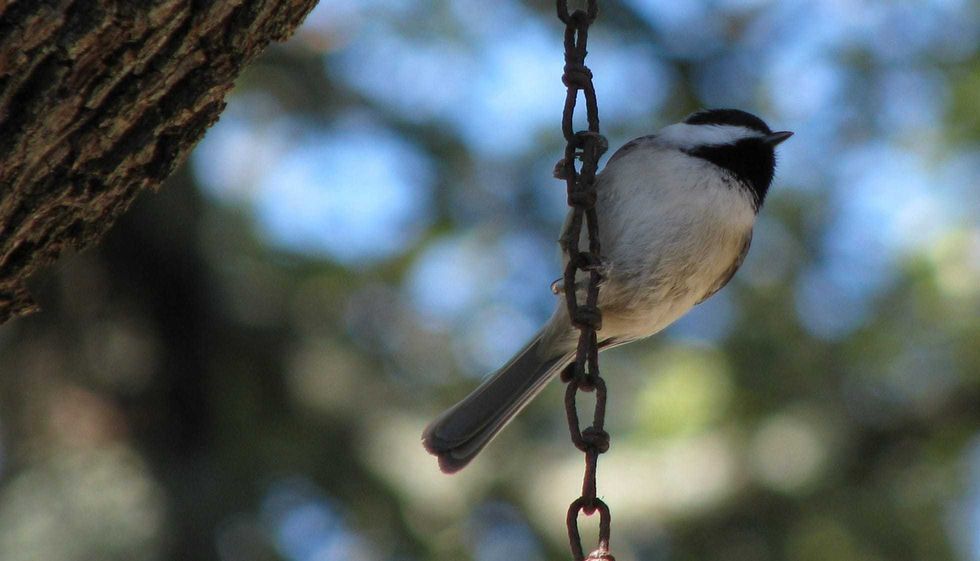Chickadees are small songbirds of the Paridae family, order Passeriformes. They refer to a group of North American birds sharing certain characteristics. Birds of the same genus found in areas other than North America are known as tits. This subcategory includes species like the sultan tit and yellow-browed tit. These birds are extremely vibrant in appearance.
All chickadees share common characteristics such as a head cap and dual-colored plumage. Even though they are small birds, they require a lot of energy.
This is on account of its acrobatic and active lifestyle. It is estimated that they require up to 10 kcal per day. During the winter season, the food requirements might increase twenty times.
Building feeders help these little creatures have a better chance at survival. These birds are a scientific wonder for many reasons. As they store their food, it is pertinent for them to remember their hiding places.
Based on this, researchers found that chickadees have a bigger hippocampus; a part of the brain that stores information. Moreover, some subspecies are known to learn each other's calls which reflect bilingualism!
Read on to know about their distinctive call, what they eat, and the differences among the species. If you enjoyed learning about these birds, consider reading Red Bird of Paradise facts and Barn owl facts.
Chickadee Interesting Facts
What type of animal is a chickadee?
Chickadees are a North American bird of the Paridae family, order Passeriformes.
What class of animal does a chickadee belong to?
Chickadee belongs to the class Aves of the Kingdom Animalia. These songbirds collectively refer to the species clubbed under the genus Poecile.
How many chickadees are there in the world?
At present, there is no exact estimate of the global chickadee population. However, you might be interested to know about the varying trends of its different subspecies. The Mountain and Carolina Chickadee have a stable trend.
The population is not fragmented and no steep declines have been noted. On the other hand, the Mexican Chickadee population, judged to be around 2,000,000 is decreasing. Similarly, the Boreal and the Gray-Headed Chickadee or the Siberian tit's extant population (15,000,000-25,999,999) is also witnessing a downward slope.
Two species, the Black-Capped Chickadees and the Chestnut-Backed Chickadees, are the only two subspecies that display an increasing trend.
Where does a chickadee live?
Chickadees, for the most part, are non-migratory. They are present all over the continent and are a common sight at bird feeders. Chickadees population covers a wide range. The Carolina Chickadees can be found in Texas, Missouri, and Pennsylvania.
The mountains in the west have become their habitat for its namesake, the Moutain Chickadees. Boreal populates the range of Northwest states whereas the Chestnut-Backed Chickadees can be found nesting on the Pacific coast. The Mexican Chickadee range limits itself to the Arizona belt leading towards New Mexico.
What is a chickadee's habitat?
As these birds can be found nesting in such diverse states, it is obvious to expect variation in their nesting habitat as well. They can inhabit lowland conifer forests, riverine forests, and willow thickets. Other suitable habitats include shrublands and terrestrial urban areas.
Who does a chickadee live with?
Chickadees are remarkably social and tend to cohabit with other woodland birds. They can be seen in a flock with warblers, woodpeckers, vireos, and nuthatches.
How long does a chickadee live?
The longevity records of the North American birds report the minimum age at the encounter. According to these studies, this species group can live for s maximum of 5-11 years.
How do they reproduce?
The breeding site is usually selected by the female. In a few species, the male bird is also involved in the decision.
These birds tend to nest inside tree cavities. Uncommonly, they can be found breeding on the ground. They may create their cavities by removing wood shavings or taking over old woodpecker nests.
The nest is built inside the hollowed-out wood and the eggs are placed within. Some may cushion the nest by using moss wood shavings, or even animal fur. Creating caps out of fur to hide the eggs is another safety measure.
The clutch size may go up to 13 eggs, with some females breeding in multiple broods. The incubation period might vary but on average lasts for 15 days.
What is their conservation status?
The latest conservation status for the chickadees according to the International Union for Conservation of Nature Red List is Least Concern.
Chickadee Fun Facts
What do chickadees look like?

Chickadees are small songbirds. They are known for their distinctive head mask and dark-colored crown. Small variations occur across the species. For example, the Black-Capped Chickadees (Poecile atricapillus) have black caps and throats and beautiful gray plumage with white underparts. Similarly, the Mountain Chickadee has a stocky appearance and a white stripe over its eye.
How cute are they?
Chickadees are extremely cute birds. This adjective may be attributed to their small size, puffed-up appearance, and distinctive cap on their head.
How do they communicate?
Chickadees have a very distinct call. The most famous is the Black-Capped Chickadees', which is ‘chicka-dee-dee-dee’. They are known for their amazing linguistic ability. Its calls can be modified to signal different messages. The frequency of the segment dee can be increased or decreased to indicate danger and even the specific predator.
Chickadees are the only birds that supposedly possess bilingual abilities. They often flock together with other species, which may allow the Black-Capped Chickadees and the Carolina Chickadees to intermingle and learn each other's call. This fascinating research has been going on since the first observation in the year 1952 by James Tanner.
How big is a chickadee?
Chickadees are small songbirds. Its length is 2.4-5.5 in (6-14 cm). If compared to a common American Crow, it would be 8-10 times smaller.
How fast can a chickadee fly?
Chickadees have a wingspan of 8.5 in (21 cm). On average, the chickadee wingbeats are about 27 times per second. This calls for relatively high energy needs to sustain activities.
How much does a chickadee weigh?
On average, the chickadee weighs 0.3-0.5 oz (9-14 g).
What are the male and female names of the species?
There are no specific names given to the males and the female of these species.
What would you call a baby Chickadee?
A baby chickadee can be called a chick.
What do they eat?
Chickadees have an omnivorous diet. Chiefly they rely on insects and small invertebrates like spiders, caterpillars, and suet for food. They also eat sunflower seeds, peanuts, and nuts. Certain species would also glean insects from the tree barks.
They frequent bird feeders set out by people. The feeders can include food like peanut butter, seeds, suet, and mealworms. During the winter season, some species change their diet. Cornell Lab has curated a detailed list of viable food options and other feeder tips for enthusiasts.
Are they poisonous?
No, these birds are not known to be poisonous.
Would they make a good pet?
No, chickadees do not make good pets. They are known to belong to the wild. However, you can always attract them by setting up feeders with food and nest boxes in your backyard. They frequent the feeders year-round. In fact, due to their heavy dependence on insects, they can be used as a pest control measure.
Did you know...
The word chickadee is an onomatopoeia. These refer to words that are based on some naturally occurring sounds. The chickadee call is, chicka-dee-dee-dee, which became the basis for its name.
Chickadees are known for their resilience. These tiny birds do not migrate even in the harshest winter season. They catch food to prepare themselves. The availability of feeders increases their survival rates.
Do chickadees mate for life?
No, male and female chickadees tend to mate for at least a year. Once the young are grown and can be independent, they part ways.
Is a chickadee a sparrow?
No, a chickadee is not a sparrow. Chickadees can be mistaken for finches or sparrows because of their similar sizes.
Taxonomically, sparrows belong to the family Passerellidae, whereas chickadees are a part of the family Paridae. Chickadees are famous for flying in flocks whereas sparrows tend to be solitary. In terms of appearance, chickadees usually bear a face mask and have a pied appearance, aiding in identification.
Do chickadees like humans?
Yes! As social creatures, chickadees not only fly in a flock but also interact with humans. It is very easy to attract them by setting out food and seeds in a feeder or building your very own nesting box.
Here at Kidadl, we have carefully created lots of interesting family-friendly animal facts for everyone to discover! Learn more about some other birds including secretary bird facts and great green macaw facts.
You can even occupy yourself at home by drawing one on our chickadee coloring pages.










